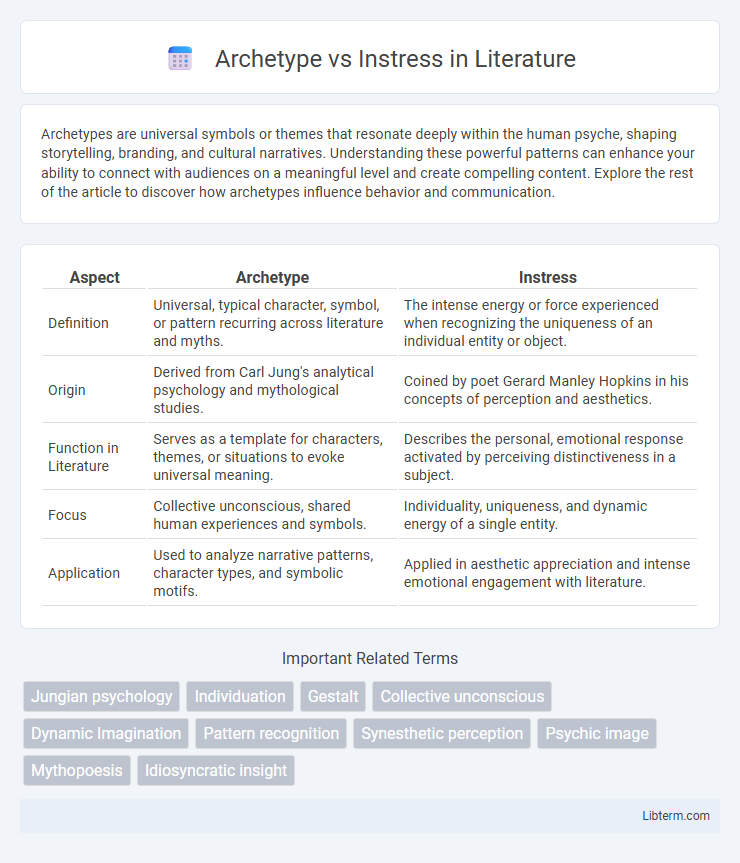Archetypes are universal symbols or themes that resonate deeply within the human psyche, shaping storytelling, branding, and cultural narratives. Understanding these powerful patterns can enhance your ability to connect with audiences on a meaningful level and create compelling content. Explore the rest of the article to discover how archetypes influence behavior and communication.
Table of Comparison
| Aspect | Archetype | Instress |
|---|---|---|
| Definition | Universal, typical character, symbol, or pattern recurring across literature and myths. | The intense energy or force experienced when recognizing the uniqueness of an individual entity or object. |
| Origin | Derived from Carl Jung's analytical psychology and mythological studies. | Coined by poet Gerard Manley Hopkins in his concepts of perception and aesthetics. |
| Function in Literature | Serves as a template for characters, themes, or situations to evoke universal meaning. | Describes the personal, emotional response activated by perceiving distinctiveness in a subject. |
| Focus | Collective unconscious, shared human experiences and symbols. | Individuality, uniqueness, and dynamic energy of a single entity. |
| Application | Used to analyze narrative patterns, character types, and symbolic motifs. | Applied in aesthetic appreciation and intense emotional engagement with literature. |
Understanding Archetype: Definition and Origins
Archetypes are universal, symbolic patterns or themes that recur across myths, literature, and cultures, reflecting fundamental human experiences and collective unconscious. Coined by Carl Jung, archetypes serve as primal templates influencing individual behavior and storytelling motifs throughout history. Their origins trace back to ancient myths and psychological theory, providing insight into shared human nature and cultural expressions.
Exploring Instress: Meaning and Literary Context
Instress captures the intense perception and energy one experiences when recognizing the unique identity of an object or person, deeply rooted in Gerard Manley Hopkins' poetry. This concept emphasizes the individual essence and dynamic force that brings life and meaning to a subject within a literary work. Exploring instress reveals how writers convey vibrant emotional and spiritual connections, enhancing thematic depth and reader engagement.
Archetype vs Instress: Key Differences
Archetype represents universal, recurring symbols or themes found in literature, art, and psychology, embodying collective unconscious patterns shared across cultures. Instress, coined by poet Gerard Manley Hopkins, refers to the intense energy or force that connects an observer to the unique essence of an object or experience. The key difference lies in archetypes being universal prototypes shaping narratives and behaviors, while instress highlights individual perception and the dynamic engagement with specific, singular moments.
Historical Roots of Archetype and Instress
Archetypes originate from Carl Jung's analytical psychology, representing universal, primordial symbols embedded in the collective unconscious that shape human experiences across cultures and history. Instress, a concept coined by poet Gerard Manley Hopkins, captures the intense energy or force in perceiving the unique essence of an individual object or moment, highlighting subjective engagement over universal patterns. The historical roots of archetype emphasize shared mythic structures, while instress centers on the dynamic encounter between observer and distinctive reality.
Archetype in Literature and Storytelling
Archetypes in literature and storytelling serve as universal symbols or character types that resonate across cultures, such as the Hero, the Mentor, or the Shadow, providing a framework that drives narrative structure and character development. Archetypes function as foundational templates that tap into collective unconscious themes identified by Carl Jung, enabling readers to connect deeply with stories on a psychological level. Instress, while related to individuality and the unique perception of an object or experience, contrasts with the fixed, recognizable patterns embodied by archetypes in shaping literary meaning.
The Role of Instress in Art and Perception
Instress plays a crucial role in art and perception by capturing the intense energy and emotional resonance that connects an observer to a work of art, transcending the mere recognition of archetypes. Unlike archetypes, which are universal symbols and motifs embedded in cultural consciousness, instress emphasizes the unique, dynamic experience of perceiving and internalizing artistic expression. This concept enriches the interpretation of art by highlighting the subjective, immediate impact that stirs deeper emotional and cognitive engagement.
Comparative Analysis: Archetype and Instress
Archetype represents universal, recurring symbols or motifs deeply embedded in the collective unconscious, while Instress refers to the intense perception of the unique essence in a particular object or moment. Archetypes function as shared cognitive templates shaping human experience across cultures, whereas Instress emphasizes individual, immediate engagement with reality, highlighting personal insight and emotional resonance. Comparative analysis reveals Archetype's foundational role in forming common meanings contrasted with Instress's dynamic process of recognizing distinctiveness within those meanings.
Psychological Influence of Archetypes and Instress
Archetypes, as universal symbols embedded in the collective unconscious, shape psychological behavior by triggering innate emotional responses and guiding individual identity formation. Instress, as the intense perception of unique experiences, enhances self-awareness and personal meaning by connecting individuals to distinct moments of reality. Together, archetypes provide a structural framework for understanding human motivations, while instress fosters deep, subjective engagement with those psychological patterns.
Modern Applications: Archetype and Instress Today
Archetypes serve as fundamental psychological patterns influencing branding, storytelling, and user experience design, enabling deeper emotional connections and cultural relevance. Instress, the recognition and emotional energy derived from experiencing distinct individuality in objects or ideas, enhances creativity and innovation in fields like art, marketing, and virtual reality. Modern applications leverage archetypes for structured narrative frameworks while using instress to inspire unique, immersive experiences that resonate authentically with diverse audiences.
Conclusion: Integrating Archetype and Instress in Creative Work
Integrating archetype and instress in creative work enriches the artistic process by merging universal symbols with individual perception, fostering originality rooted in collective meaning. This synthesis enhances narrative depth and emotional resonance, allowing creators to tap into both shared cultural patterns and personal insights. The balanced application of archetypes and instress drives innovation, connecting audiences through familiar motifs while offering unique, resonant experiences.
Archetype Infographic

 libterm.com
libterm.com